As Germany prepares to host the UEFA Euro 2024, the nation stands on the precipice of a tournament filled with both historical prestige and immense pressure.
The German national team, with a storied legacy that includes four World Cup titles, one Confederations Cup triumph, and three European Championship victories, is once again one of the favourites to lift the trophy on home soil.
Recent tournaments have seen Germany falter despite their illustrious past, exiting earlier than anticipated and casting doubts over their current form.
After a highly successful tenure under Joachim Löw, which included a World Cup win in 2014, the team struggled to replicate such heights under his successor, Hansi Flick.
This led to a significant change in leadership with the appointment of Julian Nagelsmann, a promising young coach who left Bayern Munich over a year ago.
Nagelsmann’s arrival has sparked renewed hope and strategic adjustments within the squad.
Regardless of the outcome at the Euros, the German Football Association has shown faith in Nagelsmann by extending his contract until 2026, tasking him with leading the national team through to the next World Cup in America.
As Germany gears up for the Euro 2024 on home turf, expectations are sky-high.
Fans and pundits alike are eager to see how Nagelsmann’s tactical acumen and fresh approach will fare in what promises to be a fiercely competitive tournament.
This tactical analysis delves into the strategies and formations that Nagelsmann might employ to ensure Germany not only meets but exceeds these lofty expectations, aiming to reclaim their position at the pinnacle of European football.
Predicted Starting XI
As Germany gears up for the UEFA Euro 2024, head coach Julian Nagelsmann has been meticulously crafting a squad that blends experience with youthful exuberance.
Julian Nagelsmann has managed Germany for six matches since taking over from Hansi Flick, employing three different formations.
The 4-2-3-1 formation has been the most frequently used, featuring in four matches, followed by a 4-4-2 and a 3-4-2-1, each with varying degrees of success.
Nagelsmann appears to be experimenting with different systems to find the best fit for a squad that has faced challenges maintaining consistent form over the past 18 months.
Given his past preference for the 4-2-3-1 formation during his tenure at Bayern Munich, Nagelsmann may opt for this system as his preferred choice for the German national team.
Following impressive victories in recent friendlies against the Netherlands and France, a 4-2-3-1 formation still appears to be Nagelsmann’s preferred tactical setup.
This formation has demonstrated its effectiveness, allowing Germany to dominate possession while maintaining a solid defensive structure.
Here’s a look at the predicted lineup that Nagelsmann might deploy for the tournament: Manuel Neuer – Maximilian Mittelstädt, Antonio Rüdiger, Jonathan Tah, Joshua Kimmich – Toni Kroos, Robert Andrich – Jamal Musiala, Ilkay Gündogan, Florian Wirtz – Kai Havertz.
We’ll go into more detail about every single player from this line-up later in this analysis.
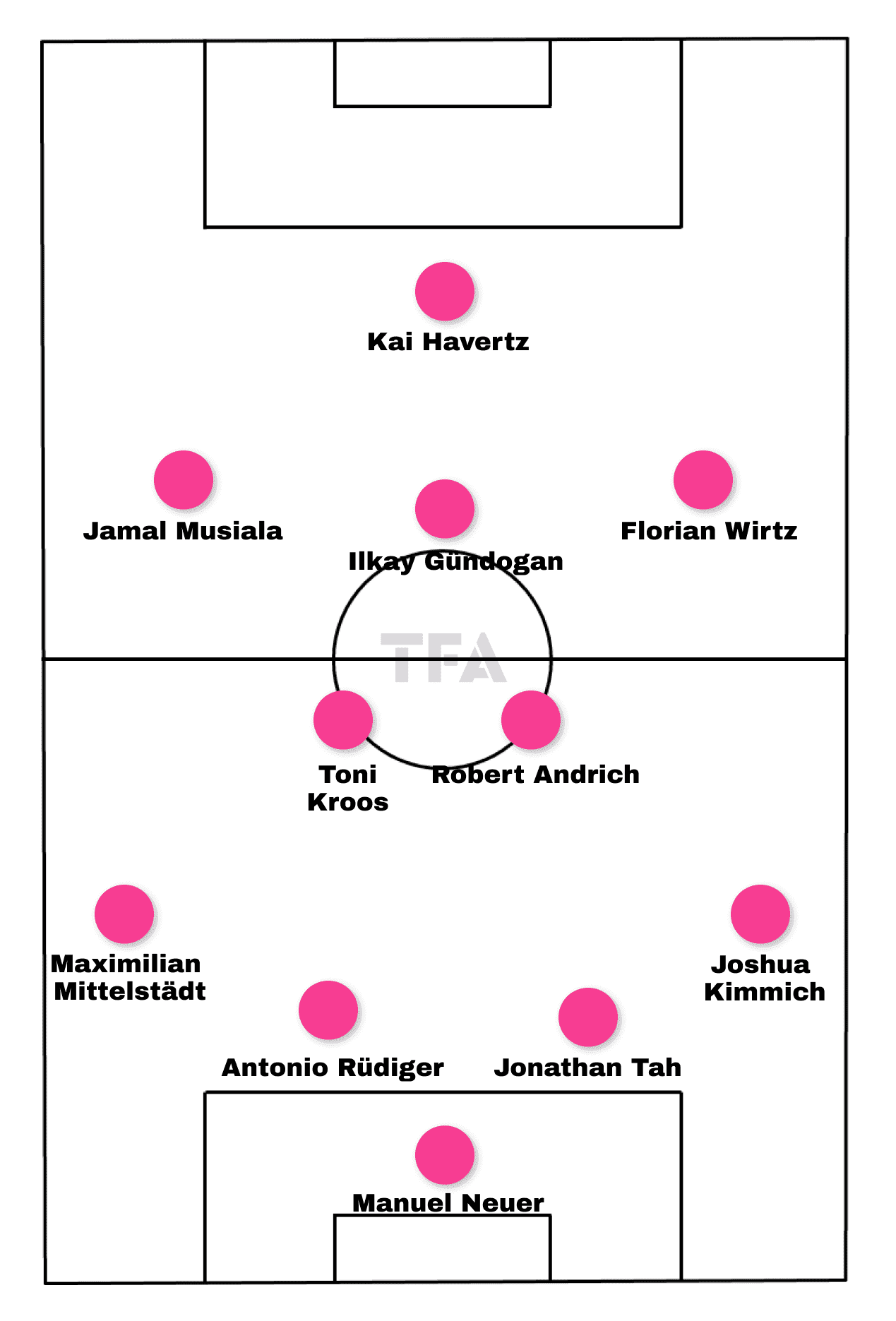
For the rest of the squad selected by head coach Julian Nagelsmann, the coach surprised by nominating three further goalkeepers besides Manuel Neuer.
Marc-André ter Stegen, one of the most reliable goalkeepers in the world, provides a strong alternative to Manuel Neuer.
His outstanding performances for Barcelona have cemented his reputation as a top-tier shot-stopper.
Oliver Baumann, with his extensive Bundesliga experience, brings reliability and consistency.
He is a solid backup option who can step in confidently if needed.
Alexander Nübel, seen as a future goalkeeper of the team, has been gaining valuable experience on loan with surprising side VfB Stuttgart.
Waldemar Anton offers versatility and strength in central defence.
His ability to play in multiple defensive roles makes him a valuable squad member.
Robin Koch, known for his solid defensive skills and aerial prowess, adds depth to Germany’s central defensive options.
His experience in the Premier League has enhanced his tactical awareness.
His recent performance were not on top.
It’s surprising that Nagelsmann put his faith in Koch instead of Mats Hummels, who played an outstanding second half of the season, leading Borussia Dortmund into the UEFA Champions League Final.
Nico Schlotterbeck, a rising star, brings energy and composure to the backline.
His performances for Borussia Dortmund have shown his potential to be a mainstay in Germany’s defence for years to come.
David Raum, with his attacking flair from the left-back position, provides an option for adding width to Germany’s play.
However, his inconsistent performances this season will be something to watch.
Benjamin Henrichs offers flexibility, being able to play on both defensive flanks.
His versatility is crucial for adjusting tactical setups during the tournament.
In central midfield, Pascal Groß brings experience and composure to the defensive midfield.
His passing range and tactical intelligence are key for controlling the game’s tempo.
Aleksandar Pavlovic, a promising young talent, adds a youthful spark to the midfield.
His inclusion is an investment in the future, providing him with invaluable experience on the international stage.
Chris Führich, a dynamic winger, can inject pace and creativity into the midfield.
His ability to beat defenders and deliver crosses will be an asset.
Leroy Sané, with his explosive pace and dribbling ability, is a major attacking threat.
He can operate on both wings, making him a versatile asset for Nagelsmann.
It’ ‘s also possible that he is a candidate for the starting line-up in certain games.
Thomas Müller, a veteran with vast international experience, provides leadership and tactical intelligence.
His ability to play as a forward or attacking midfielder adds flexibility to the lineup.
Maximilian Beier, a young and promising striker, brings energy and a keen eye for goal.
His potential makes him an exciting inclusion in the squad.
Niclas Füllkrug, a seasoned striker, offers physical presence and aerial threat in the forward line.
His experience and goal-scoring ability are vital for Germany’s attacking options.
Deniz Undav, with his sharp finishing and movement, is a valuable addition to the attack.
His consistent club-level goalscoring form earns him a spot in the squad.
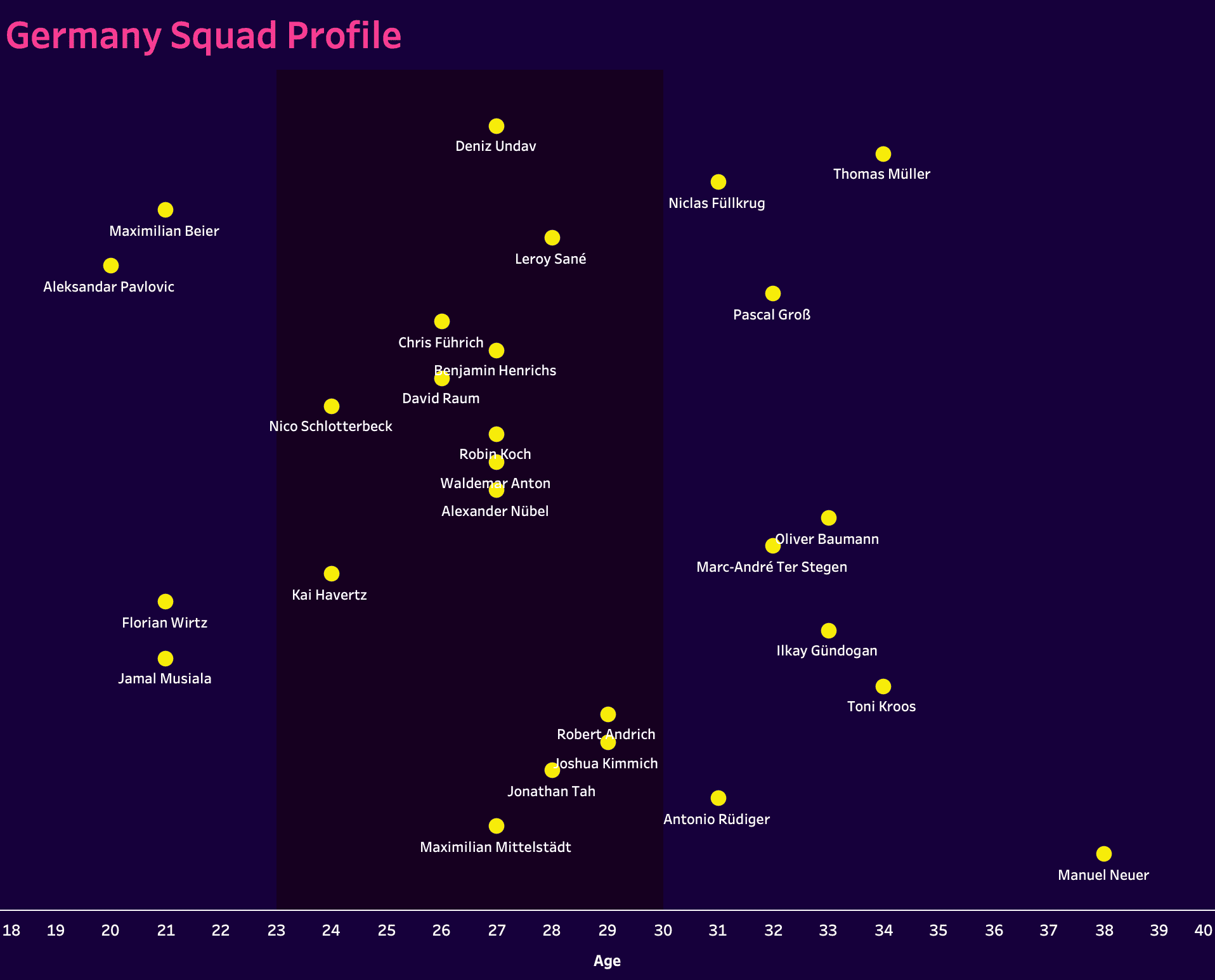
Overall, Julian Nagelsmann has assembled a well-rounded squad for the UEFA Euro 2024, blending the wisdom of experienced veterans with the enthusiasm of emerging talents.
This team composition ensures that Germany is well-prepared to tackle the challenges of the tournament and meet the high expectations of playing a successful home Euros.
Attacking Phase
In their attacking phase, Germany’s approach centres around maintaining structured ball possession, with Toni Kroos playing a pivotal role as the central midfielder.
Kroos is often found in a half-left position on the field, sometimes dropping back alongside the centre-backs to initiate play and ensure a secure buildup.
While Robert Andrich can also perform this role, Kroos is more frequently utilised for this purpose.
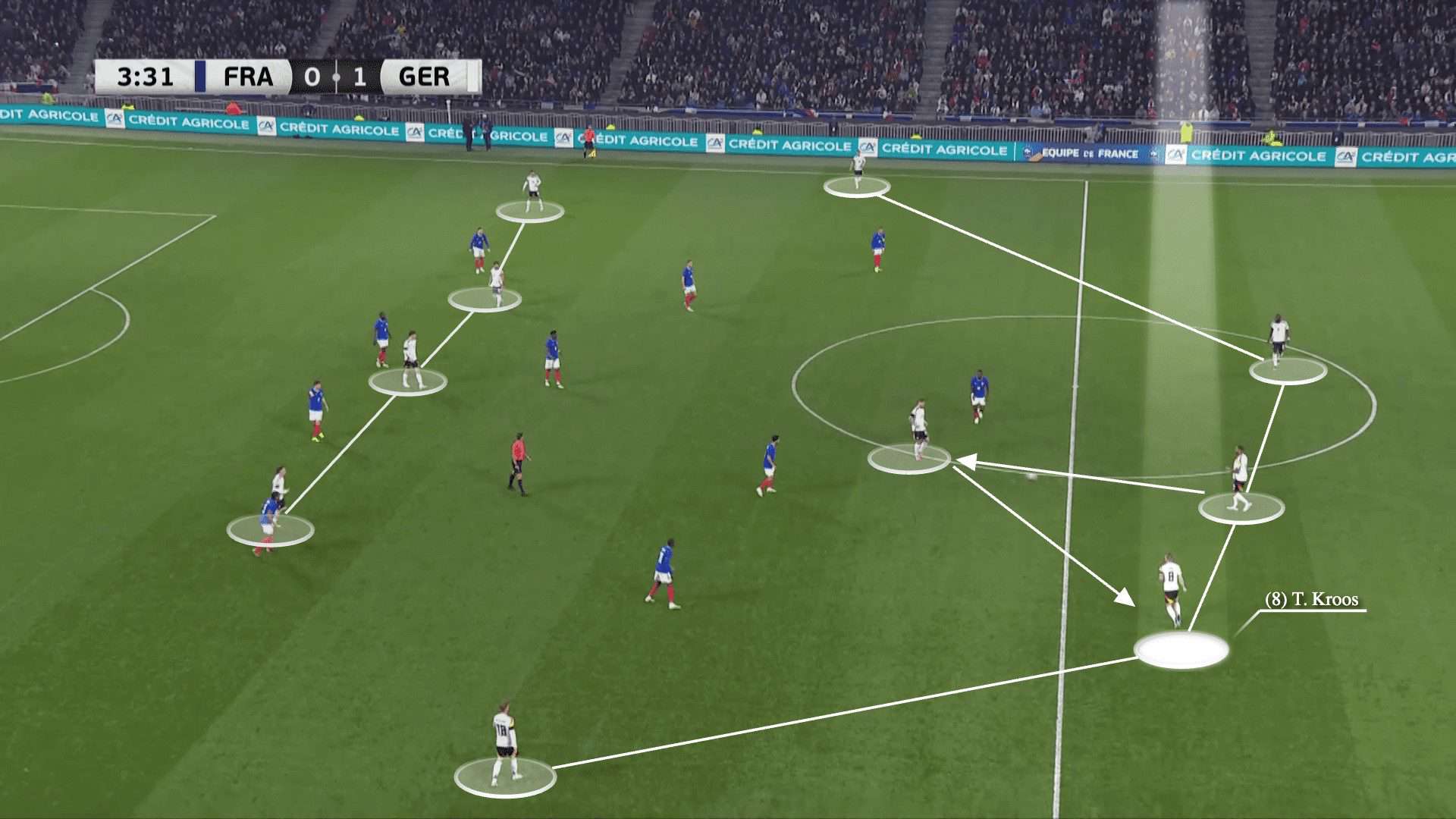
A key tactic in Germany’s strategy is the formation of a diamond shape on the flanks after the first pass bypasses the opponent’s first line of defence.
Full-backs Joshua Kimmich and Maximilian Mittelstädt push high up the field while Florian Wirtz or Jamal Musiala drop into central positions.
Meanwhile, Ilkay Gündogan makes a counter-movement into the half-space.
This movement, combined with the central midfielder and the full-back, forms a diamond with the player in possession.
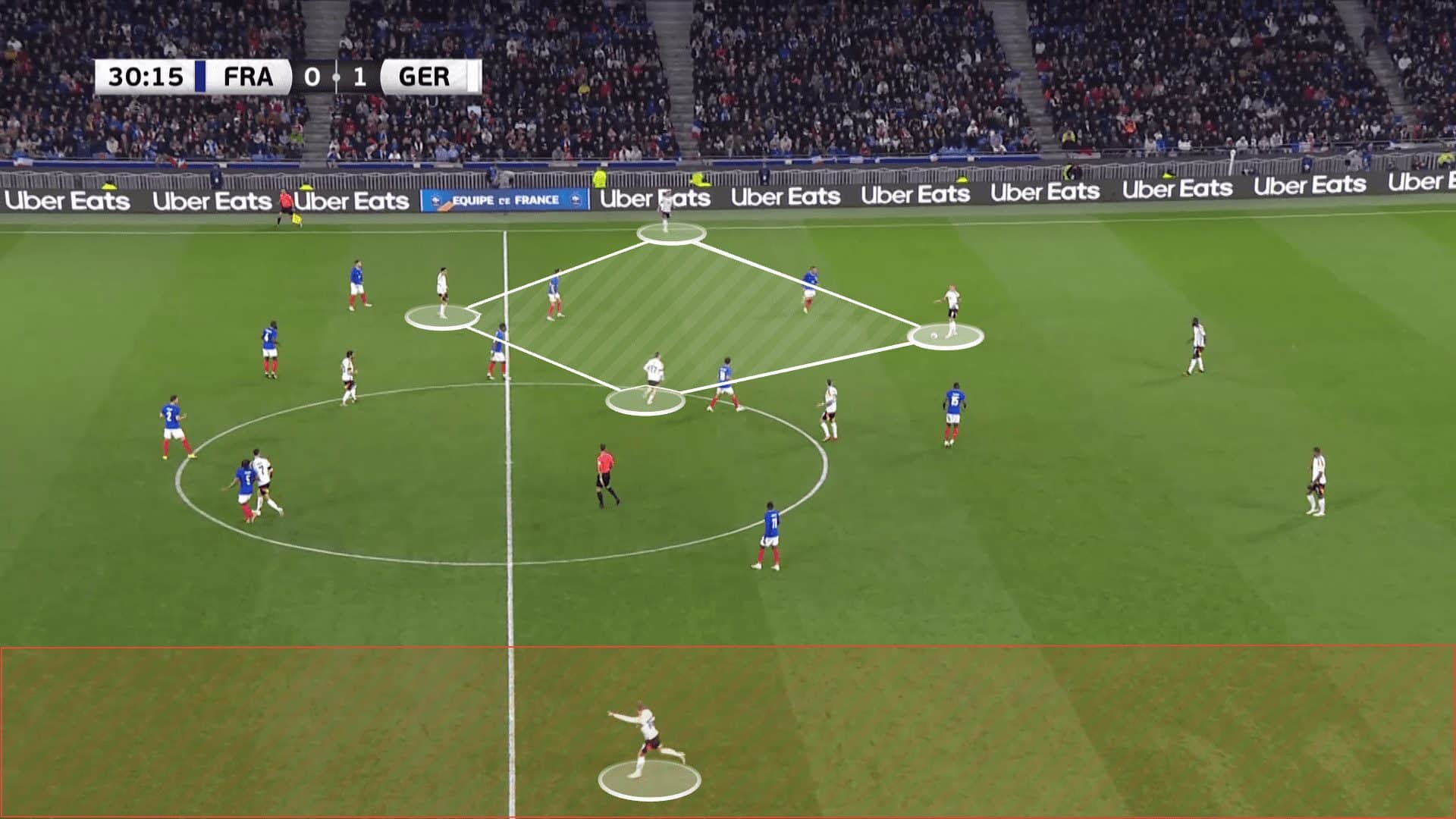
This diamond formation ensures ball security, allowing Germany to draw the opponent to one side without the risk of losing possession.
This, in turn, creates space and opportunities either in the centre or on the opposite flank.
The typical sequence involves a pass from a centre-back to Kroos or Andrich, who then drops back and attempts to open up play progressively and vertically.
They do this by finding one of three available passing options within the spaces between the opponent’s lines, either in the half-spaces or out wide through the diamond formation.
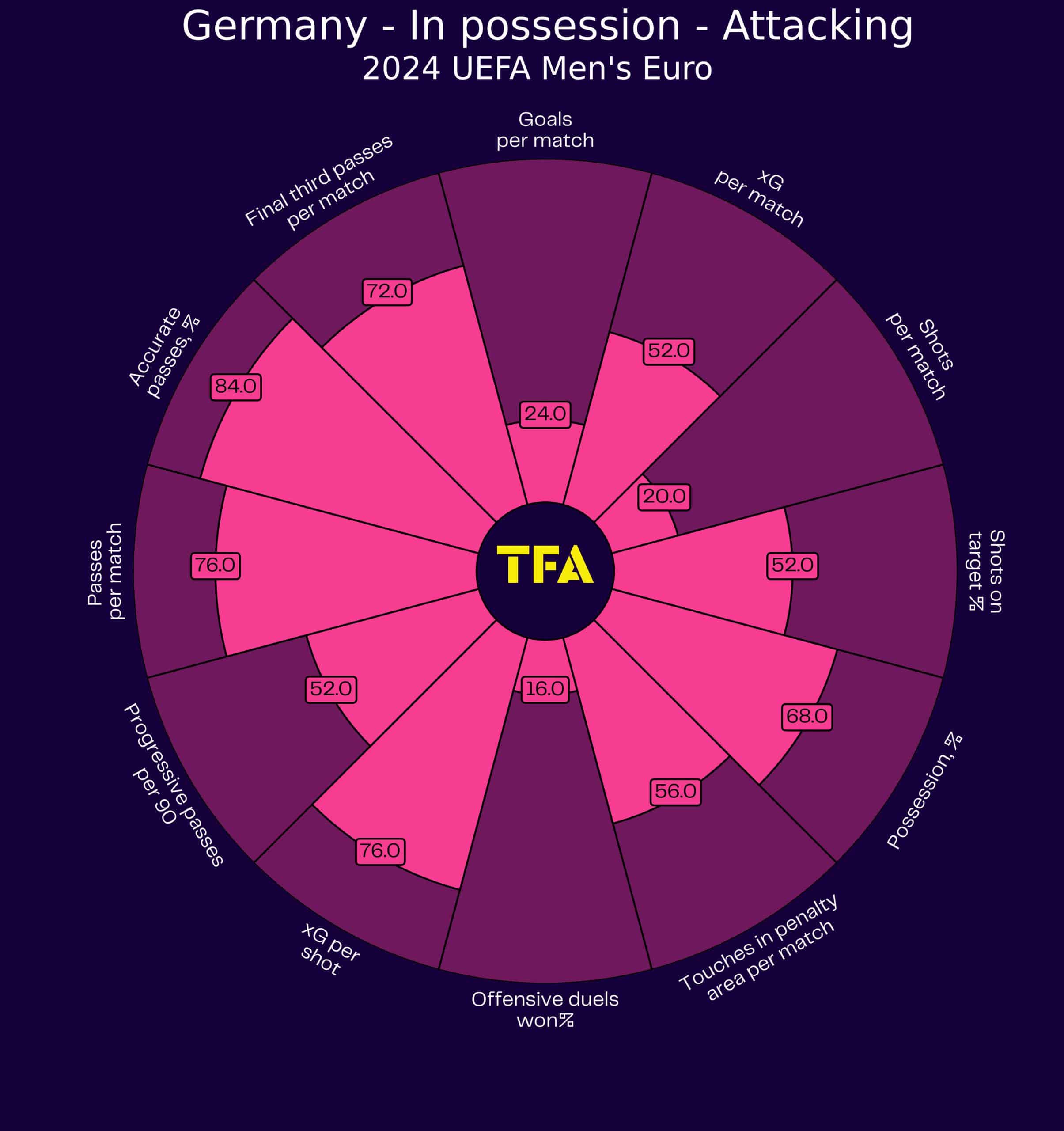
While this approach brings advantages, there are also potential risks involved.
If the opponent anticipates the diamond formation and overloads the flanks, it could disrupt Germany’s attacking rhythm.
The system heavily relies on Kroos’ and Andrich’s ability to drop back and distribute the ball effectively, which could be a weakness if they are marked out of the game.
Pushing full-backs high up the field might leave gaps in defence that can be exploited on counter-attacks.
Defensive Phase
In the defensive phase, Germany’s approach focuses on forming a block with central players like Kai Havertz, Ilkay Gündogan, Jamal Musiala, Florian Wirtz, Toni Kroos, and Robert Andrich.
This block effectively closes down the centre of the field, usually covering three central opponents, and strategically cuts off passing lanes through coordinated pressing.
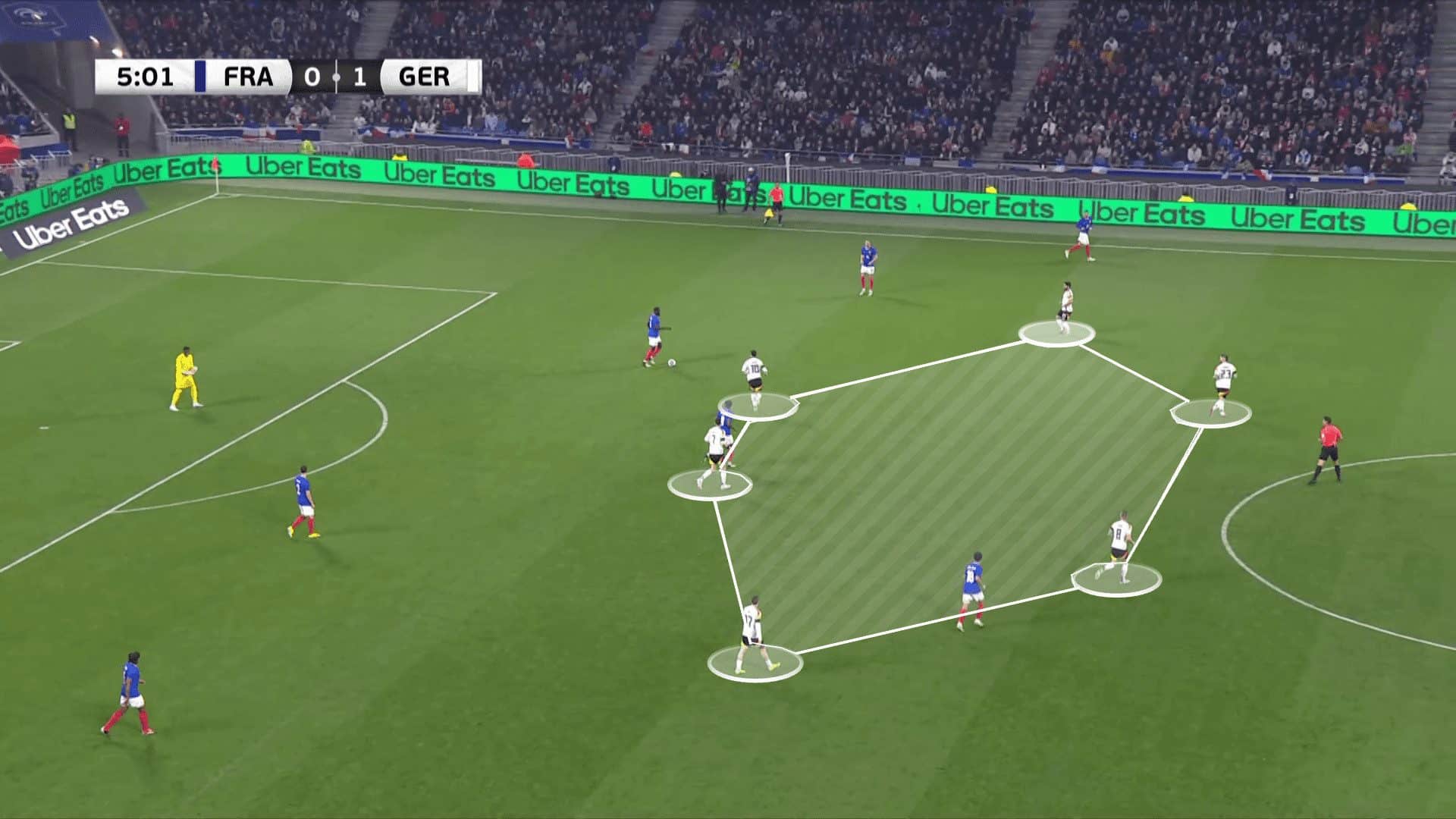
The opposition is then forced to play the ball out wide, as Julian Nagelsmann intentionally leaves these areas less congested.
Full-backs Joshua Kimmich and Maximilian Mittelstädt are positioned much deeper compared to their roles in possession phases, serving as the primary defenders on the flanks.
This structure aims to channel the opponent’s play towards the sidelines, where they are less threatening.
Additionally, one of the centre-backs can step forward if needed to intercept passes that manage to get behind the offensive block, thus preventing the opponent from breaking through the central defence.
By blocking the centre, Germany ensures that opponents cannot easily penetrate through the middle, which is typically the most dangerous area.
The strategic pressing helps in cutting off key passing lanes, making it difficult for the opposition to build their play.
Having a centre-back ready to step up and intercept passes adds an extra layer of security and adaptability to the defensive structure.
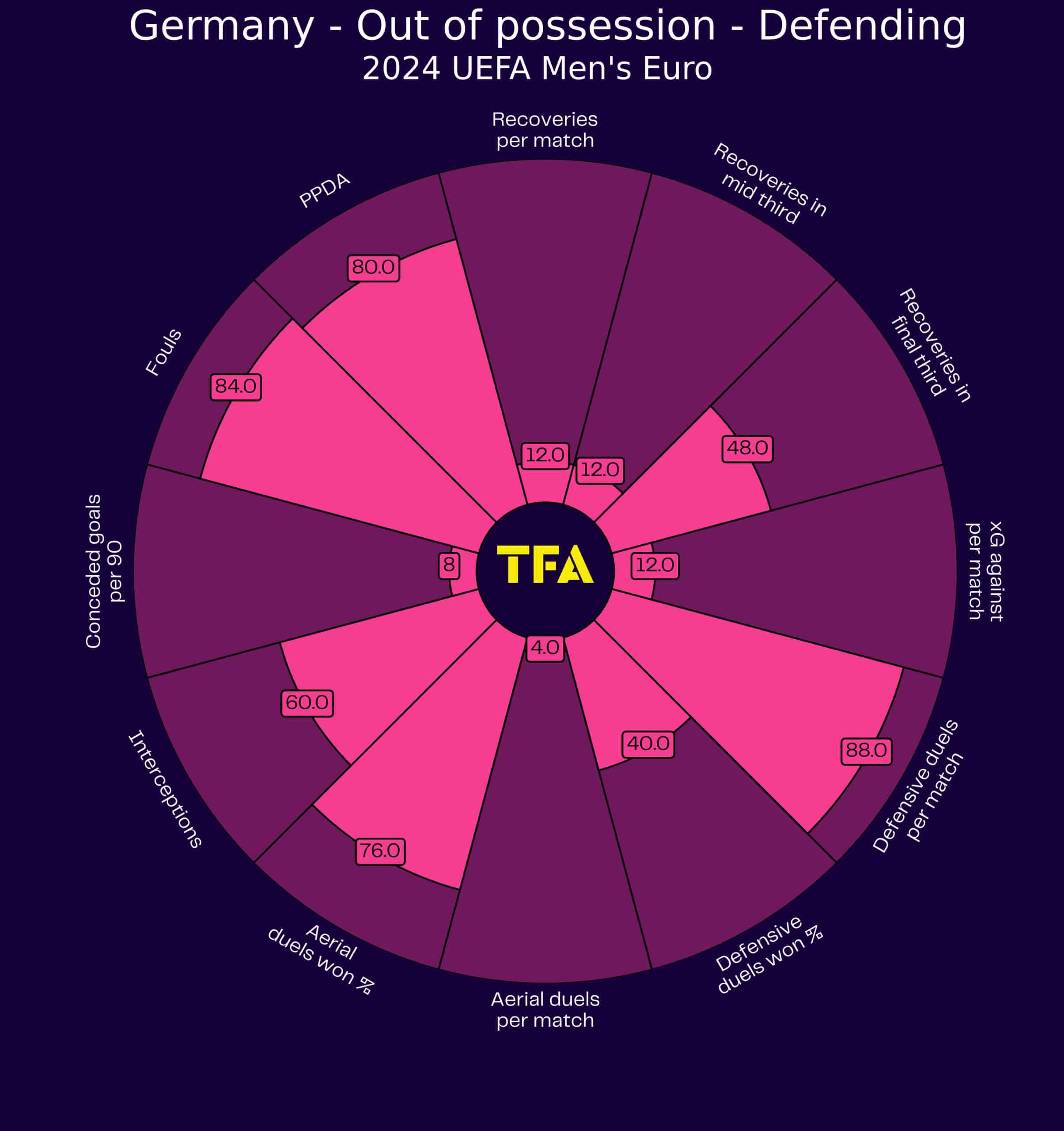
However, by focusing on the center, the flanks are left more open, which opponents with strong wing play can exploit.
This system requires high levels of coordination and discipline among the central players to effectively close down spaces and cut off passing lanes.
Kimmich and Mittelstädt have to cover large areas on the flanks, which can be physically demanding and leave them vulnerable if they are isolated against quick wingers.
Transitions
In the transition phase, Germany adopt a high-intensity counter-pressing strategy centred around dominating the middle of the field.
When possession is lost, Jamal Musiala and Florian Wirtz tuck in from their wide positions, forming a compact central block.
Ilkay Gündogan plays as a more defensive number 10, ready to press alongside forward Kai Havertz.
Meanwhile, Maximilian Mittelstädt and Joshua Kimmich cover the opponent’s wingers, with Jonathan Tah and Antonio Rüdiger ensuring stability in the backline.
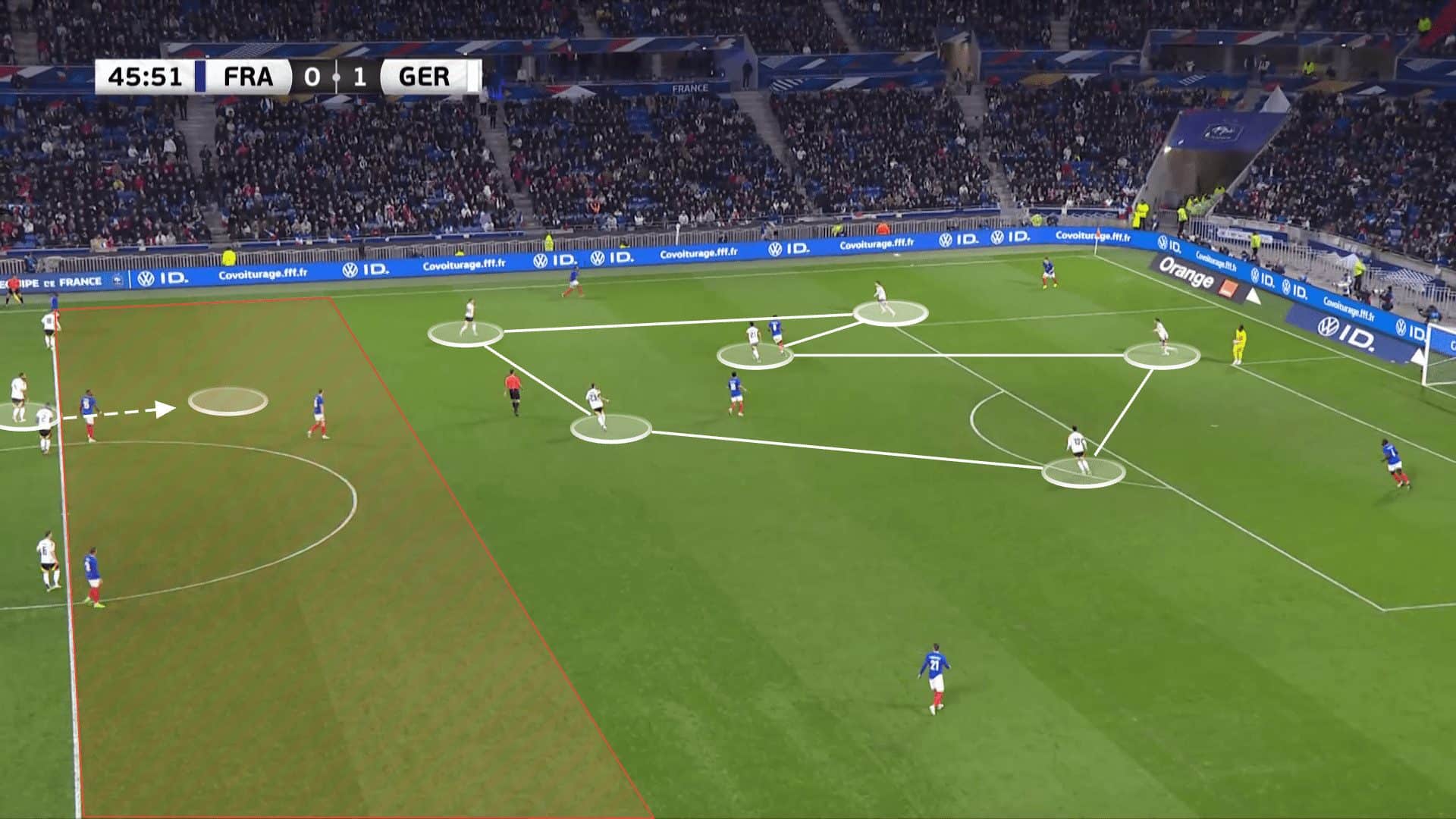
Julian Nagelsmann is renowned for this approach, emphasising a strong central presence and typically only one player on each flank.
He aims for aggressive counter-pressing with as many players as possible near the opponent’s penalty area, seeking to regain possession and quickly turn it into scoring opportunities.
Key to this strategy is the ability of skilled midfielders like Gündogan, Wirtz, Toni Kroos, and Robert Andrich to deliver precise passes through the gaps in the opponent’s defence, targeting Musiala or Havertz.
The focus is on threading balls behind the defensive line, particularly exploiting the spaces between the opponent’s full-backs and centre-backs.
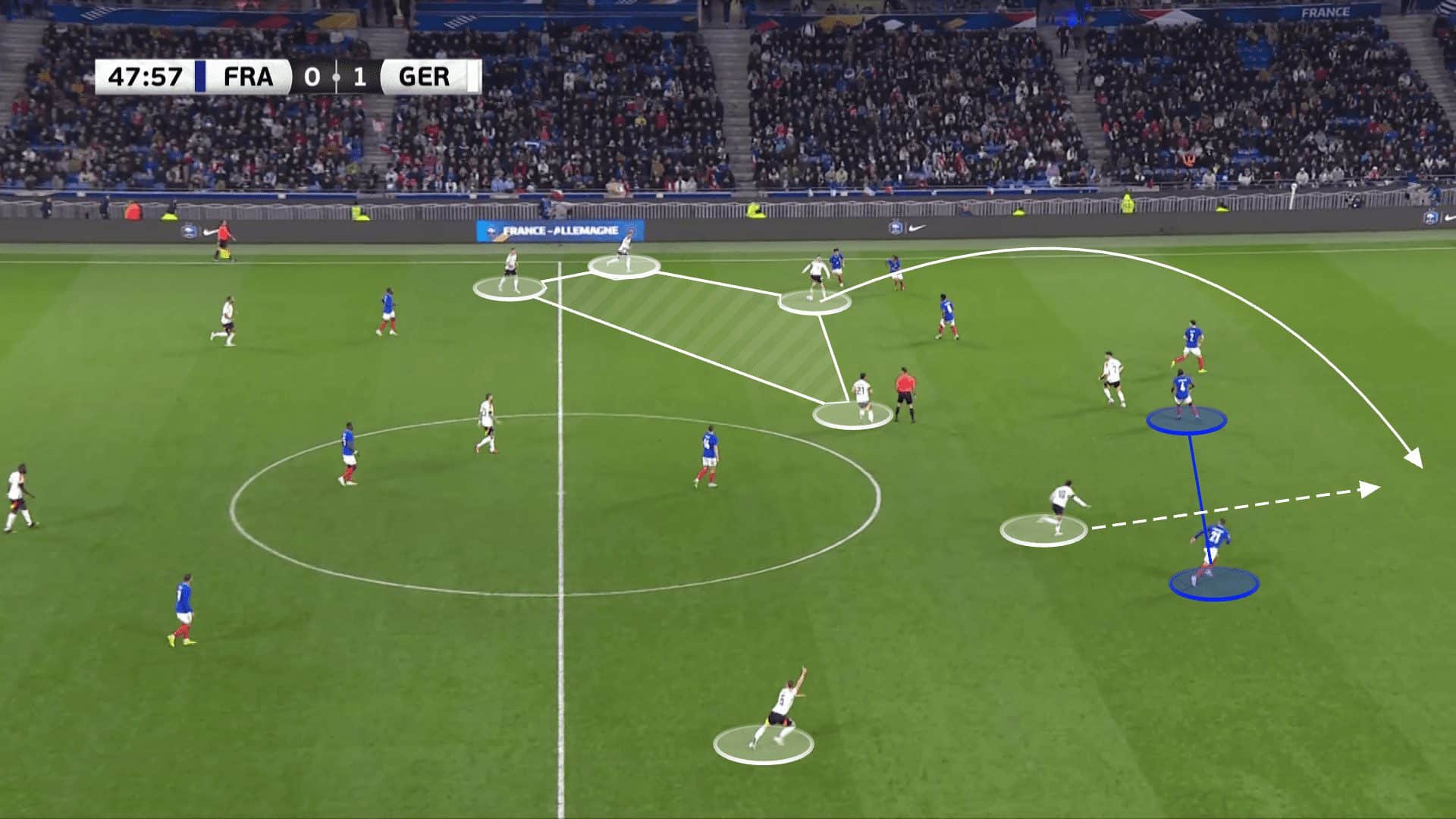
The intense counter-pressing helps win the ball back swiftly, often in dangerous areas near the opponent’s goal.
A compact centre makes it difficult for opponents to play through the middle, forcing them into less dangerous wide areas.
The strategy is designed to create immediate goal-scoring opportunities following a turnover, catching the opponent off guard.
As always, high intensity brings risks with it: Committing many players forward can leave Germany exposed to quick counter-attacks if the initial press is bypassed.
The approach requires high levels of fitness and stamina, as players must press aggressively and recover quickly.
The success of this strategy hinges on the ability of midfielders to consistently deliver accurate, incisive passes, which can be challenging under pressure.
Forwards
Kai Havertz, 24, is leading the line as a mobile centre forward.
His versatility and intelligence make him a perfect fit for the central forward role.
His ability to drop deep and link up play, clinical finishing, and aerial qualities will be key to Germany’s attacking success.
Midfielders
At 29, Robert Andrich brings a blend of defensive stability to the midfield.
His defensive acumen and passing range are essential for controlling the tempo of the game.
Toni Kroos, 34, continues to be the maestro in the midfield.
His vision, passing accuracy, and experience make him indispensable in orchestrating play from deeper positions in his last tournament in professional football before retiring.
Jamal Musiala, at just 21, is one of Germany’s brightest young talents.
His creativity, dribbling skills, and ability to break through defences make him a constant threat on the left wing while always trying to get in more central spaces.
Ilkay Gündogan, 33, is expected to take on the role of the captain and playmaker.
His ability to link midfield and attack, coupled with his goal-scoring prowess, makes him a vital cog in Nagelsmann’s system.
Florian Wirtz, also 21, adds youthful energy and creativity to the right wing.
His vision and ability to exploit spaces will be crucial in breaking down opposition defences.
Defenders
At 38, Manuel Neuer remains a pillar of experience and leadership at the back.
Despite recent struggles, including notable mistakes in the Champions League against Real Madrid and in the Bundesliga, Nagelsmann has shown faith in the veteran keeper.
However, with Marc-André ter Stegen in excellent form, the goalkeeper position remains a point of discussion, and there could be a shift if Neuer’s form does not improve.
Maximilian Mittelstädt, at 27, has shown promise as a left-back but lacks the extensive international experience of his peers.
His performances will be under scrutiny, especially with David Raum as the only backup, who has also struggled with consistency this season.
Antonio Rüdiger brings strength and reliability to the defence.
At 31, his experience at the highest levels of club football, including successful stints at Chelsea and Real Madrid, makes him a vital component of the backline.
Jonathan Tah, aged 28, partners Rüdiger to form a robust central defensive pairing.
His physicality and composure under pressure will be crucial in Germany’s defensive solidity after a successful season with Bayer Leverkusen.
Joshua Kimmich, primarily known for his midfield prowess, is expected to slot in at right back.
His versatility and tactical intelligence allow him to contribute both defensively and offensively, providing crucial support down the right flank.
Key Player
Toni Kroos stands out as the key player in Germany’s squad for the UEFA Euro 2024 thanks to his exceptional vision, precise passing, and vast experience on the international stage.
As a central midfielder, Kroos serves as the linchpin of the team’s ball-possession strategy.
His ability to dictate the tempo of the game, whether by controlling the pace or switching play, makes him indispensable in orchestrating Germany’s attacks.
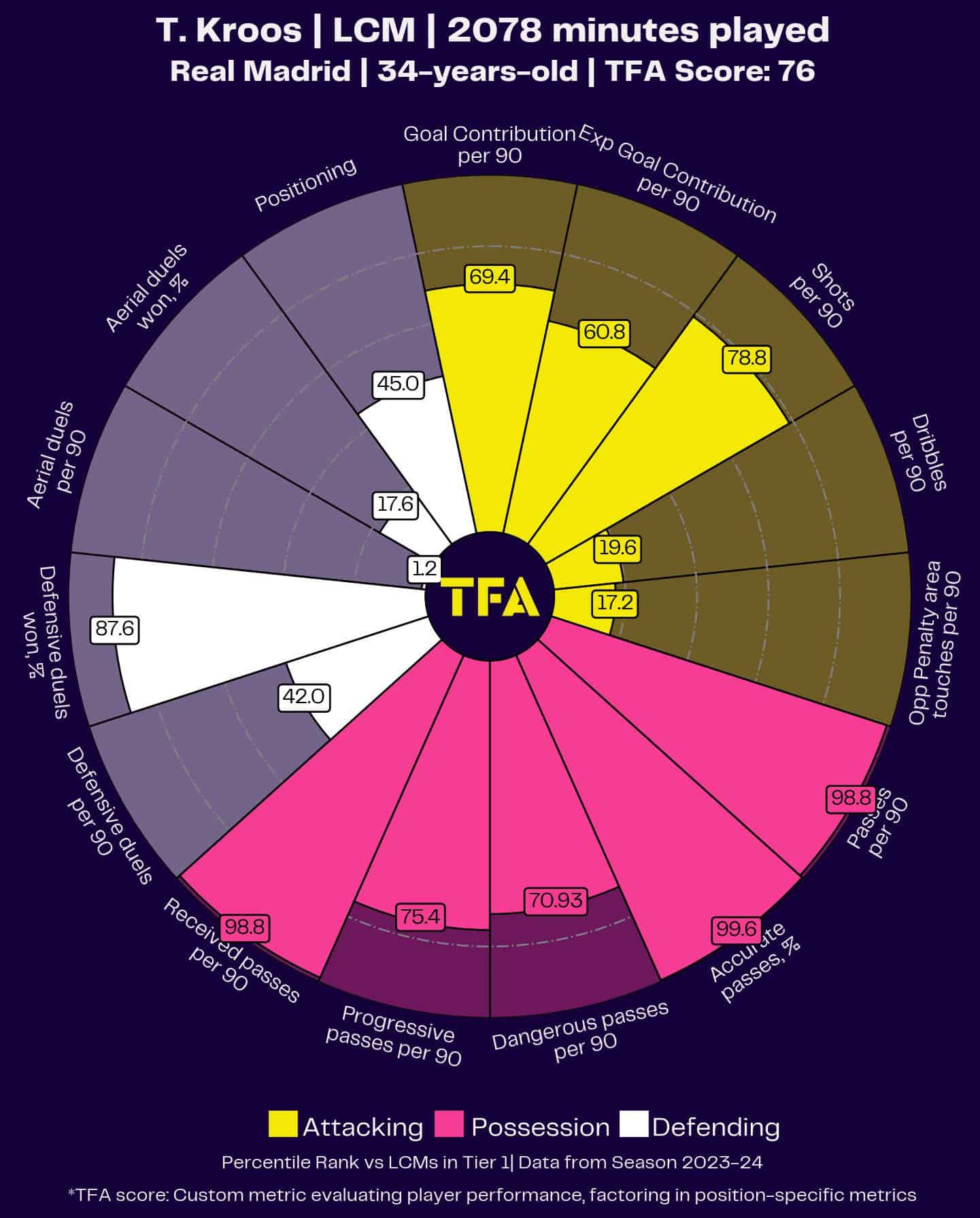
One of Kroos’s primary responsibilities is to drop deep, often positioning himself between the centre-backs, to facilitate a smooth build-up from the back.
This role allows him to use his superb passing range to progress the ball vertically and find players in advanced positions.
His knack for finding and exploiting spaces on the field is critical for breaking down organised defences.
Moreover, Kroos’s calm demeanour and decision-making under pressure provide stability to the team, especially in high-stakes matches.
His experience is invaluable, honed by years of playing at the highest level with Real Madrid and in major international tournaments.
Kroos’s leadership on the field ensures that the younger players around him remain composed and focused.
Another aspect that makes Kroos crucial is his role in set-pieces.
His deliveries from corners and free-kicks are consistently dangerous, adding another dimension to Germany’s attacking arsenal.
Whether it’s delivering pinpoint crosses or taking direct shots on goal, his set-piece proficiency can turn the tide in tightly contested games.
Tournament Prediction
As Germany prepares to host the UEFA Euro 2024, there is a palpable sense of anticipation and expectation.
The tournament presents an excellent opportunity for the four-time World Cup champions and three-time European champions to reclaim their status as a dominant force in international football, especially after recent underwhelming performances in major tournaments.
Germany is placed in Group A and is widely expected to top the group, given their talent and home advantage.
Winning the opening match against Schottland might be decisive already.
Winning the group would set them up for a round of 16 clash against the runners-up of Group C, with Denmark being a likely opponent.
Denmark, known for their resilience and tactical discipline, would provide a stern test, but Germany’s depth and quality should see them through.
Assuming Germany advances past Denmark, they would likely face the winners of Group B in the quarter-finals.
Spain, a team renowned for their technical skill and possession-based football, is the probable opponent.
This match could be a thrilling encounter, pitting two of Europe’s footballing giants against each other.
In such a high-stakes game, Germany’s tactical flexibility under Julian Nagelsmann and the home crowd’s support could be decisive factors.
Progressing to the semi-finals would likely bring Germany up against teams like Portugal, the Netherlands, or Slovakia.
Portugal, with their attacking prowess and experienced squad, would be formidable opponents.
The Netherlands, known for their tactical acumen and youthful exuberance, could also pose significant challenges.
Slovakia, while considered an underdog, should not be underestimated either.
Reaching the final would be a testament to Germany’s resurgence under Nagelsmann.
Potential opponents in the final could include traditional powerhouses like France or England.
France, with their star-studded lineup, and England, with their dynamic and youthful squad, would both be tough adversaries.
Playing on home soil in front of passionate German supporters could provide the crucial advantage needed to clinch the title.
Germany’s journey through the tournament is poised to be challenging but achievable.
With the right blend of tactical discipline, individual brilliance, and the invaluable home advantage, Germany has a strong chance of reaching the final.
Winning the tournament would mark a remarkable turnaround for the national team and reaffirm their place at the pinnacle of European football.
With Nagelsmann at the helm and a squad brimming with talent, Germany is well-positioned to make a deep run in Euro 2024, potentially culminating in lifting the trophy on home soil.

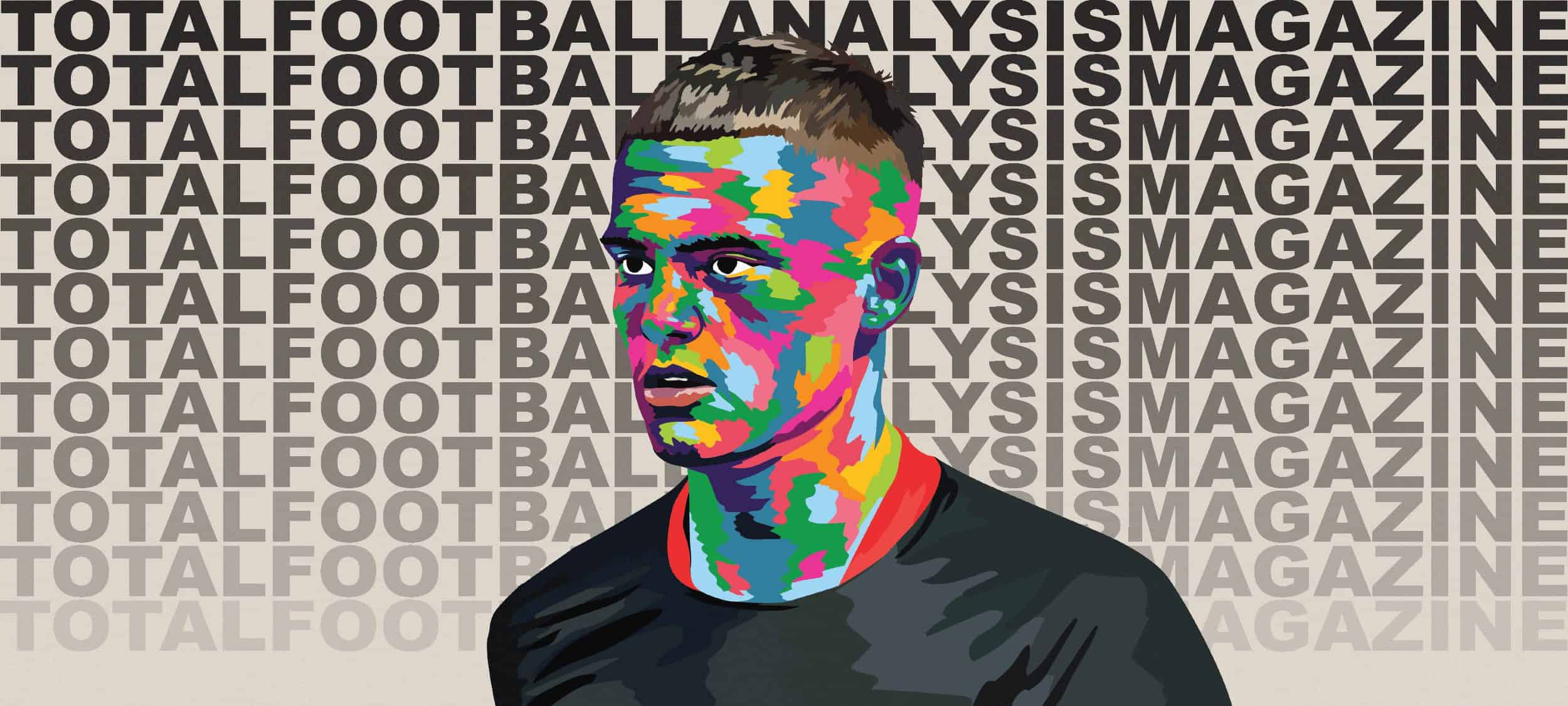



Comments